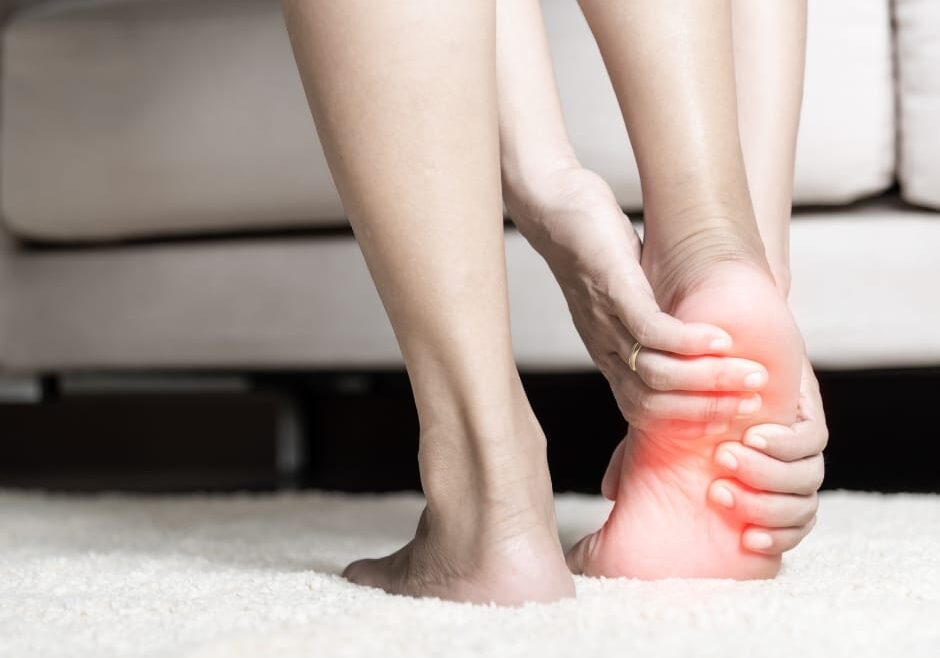
Plantar fasciitis … you might have heard this term before. It is one of the most common causes of heel and arch pain and can be debilitating, affecting your ability to walk or stand comfortably. Plantar fasciitis may come and go, and can be a real pain that can alter your daily life.
What exactly is plantar fasciitis? It’s a condition where the plantar fascia, a thick band of tissue running across the bottom of your foot from your heel to your toes, becomes overstressed or strained, leading to pain and inflammation.
The causes and risk factors of plantar fasciitis may include:
- Overuse: Excessive running, walking, or standing can strain the plantar fascia.
- Foot Mechanics: Flat feet, high arches, or an abnormal walking pattern can add stress.
- Age: It’s more common in individuals aged 40-60.
- Weight: Extra body weight can increase pressure on your plantar fascia.
- Improper Footwear: Shoes with poor arch support can exacerbate the condition.
Treatment Options
Custom Made Orthotics
Custom orthotics can help in many ways:
- Enhance Arch Support – designed to match the unique shape and arch of your foot, helping to distribute pressure evenly across the plantar fascia.
- Improve Cushioning – cushion to the heel and forefoot areas, which can help absorb shock and reduce the impact on the plantar fascia during activities.
- Increase Alignment – correct abnormal foot mechanics, such as overpronation (excessive inward rolling) or supination (outward rolling).
- Reduce Pain – address the underlying biomechanical issues.
- Prevention of Further Injury – help to lessen the risk of developing other foot-related issues, such as metatarsalgia or Achilles tendinitis.
Proper Orthopedic Footwear
- Sturdy, light-weight, cushioned, shoes with a firm base and arch support.
- Removable insoles to accommodate custom or OTC orthotics.
- Avoid walking barefoot on hard surfaces and consider using indoor shoes or slippers/sandals at home.
Night Splint
- A rigid brace that locks your ankle in place and stretches your calf and the arch of your foot while you rest or sleep, preventing morning pain.
Compression Sleeve
- Improves blood circulation and provides compression to the area to reduce swelling.
Rest and Ice
- Avoid activities that put stress on your heels, such as running/standing for long periods.
- Apply an ice pack to the affected area for 15-20 minutes several times a day to reduce inflammation.
Stretching and Strengthening Exercises
- Plantar Fascia Stretch: Sit down, cross one leg over the other, and pull the toes of your affected foot toward you. Hold for 30-60 seconds and repeat several times.
- Towel Stretch: Sit with your legs extended, loop a towel around the ball of your foot, and gently pull your foot toward you. Hold for 30-60 seconds and repeat.
Other Treatments
Other options that help with plantar fasciitis pain include physical therapy, nonsteroidal anti-inflammatory drugs like ibuprofen can help reduce pain and inflammation, steroid injections, and shockwave therapy.
Preventing Plantar Fasciitis
- Wear proper sturdy orthopedic shoes with cushion and arch support when standing or walking for long periods.
- Alternate between different types of physical activities to avoid overuse injuries.
- Incorporate foot and calf stretches into your daily routine to maintain flexibility.
Plantar fasciitis can be a painful and persistent condition, but with the right approach, it is manageable and often curable. By combining several of these remedies, you can alleviate your pain and get back on your feet.

Want to Get Started? Book an Appointment at Our Orthotics Clinic
18307 Yonge St. Unit 3
East Gwillimbury ON, L9N 0A2
